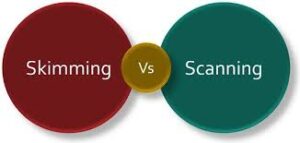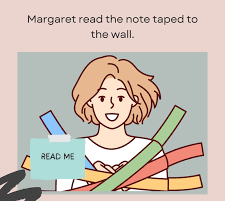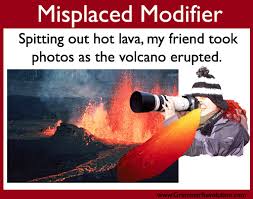READING SKILLS
INTRODUCTION
1. Understanding what we read is the most demanding aspect of reading.
2. To comprehend what we read, we need to acquire reading techniques.
3. Reading becomes more meaningful and enjoyable after implementing reading techniques
IMPROVING COMPREHENSION SKILLS
1. Don’t limit yourself to textbooks only, rather read a variety of materials like journals, articles, magazines and newspaper.
2. Circle unfamiliar words you read and refer dictionary for meanings
3. After reading, recall as much as of the information as possible.
4. Answer the questions about the material after reading.
Techniques for Good Comprehension



Skimming and Scanning
- Skimming: Reading a text quickly to get a general idea of meaning.
- Example, Reading the topic of an essay and its outlines.
- Scanning: reading the text in more detail and looking for specific information that you are interested in.
- Example, you are reading the essay in detail to grab some specific information on the topic.
Non-verbal signals
Fonts, bold prints, underlining, italics, headings, title, subheadings, photographs, captions, figures, graphs, bars, charts, etc.
Structure of the text
- A text generally starts with a title, sometimes a subtitle.
- then comes introduction, the body and conclusion.
- The important aspect of reading is prediction, the better you can predict what you are going to read, the faster you can read and comprehend.
- Body of the text consists of several paragraphs, and they are linked in a logical way, each paragraph deals with one aspect of the subject matter.
Structure of paragraphs
- A paragraph consists of 3 parts
- The 1st part is the topic sentence
- The 2nd part of the paragraph develops support for the topic sentence
- The 3rd part is a summary of the paragraph, conclusion.
Punctuation
- Based on grammar
- Understanding the meaning and usage of punctuation marks, makes easier to understand the grammatical structures of the text.
Author’s viewpoint
- You can find the author’s position in the text, while reading it.
- If the author adds words like fortunately or unfortunately, /she shows her or his approval or disapproval respectively.
- The author can also use words of surprise, regret, emotions and levels of certainty in the text. Words like, surprisingly, desirable, naturally, always, often, probably, hardly, etc.
- The author can also use words to add value to his or her viewpoint; ex, if something is very big s/he can write huge or gigantic.
Reader’s anticipation
- The reader should have a wide and flexible range of vocabulary to understand the author’s viewpoint.
- For example, determine the word; noun, verb, adverb, etc
- Determine its function in the sentences.
- Analyse the contextual clues, whether the word bears a positive or negative meaning.
- Try and derive the eventual meaning of the word.
Summarizing
- It’s very difficult to recall the contents of a long text. To recall it easily, the reader should point down some outlines or notes of the particular text.
- The length of the summary depends upon the size of the text.
- Naturally, the summary of a text should be the one third (1/3) size of the text.
- If the text is too lengthy then the size of the summary may become longer.
Typical reading comprehension questions
- After reading the passage one should become familiar with the questions asked in the standardized tests. It would help the reader to be attentive while reading the passages.
- What’s the passage trying to tell you?
- What is the tone/attitude of the author?
- What title would you give to the passage?
- What’s implied by a section in the passage?
SQ3R Reading Techniques
SURVEY
- We need to get an over-view of the text before finding out answers for the given questions.
- We can get an overview of the text by reading the title, contents, headings, subheadings, chapters, summaries, reading the introduction and conclusion, etc.
- Surveying a text is more or less equal to scanning the text.
Question
- Many a time we put several questions to ourselves to clarify something/idea.
- Such questions enable us to get a detailed idea of everything.
- Similarly, while/before reading a text, we should ask questions on its contents.
READ & RECALL
- Reading and reciting steps enable us to retain most of the information in the text.
- After surveying and questioning, we need to rad the text by focusing the main points. We may have to slow down our reading pace in case of complicated text whereas we may read fast the simple texts.
- After reading we need to recall the main points and supporting details.
REVIEW
- Last step of SQ3R
- You need to test yourself by covering the key points whether we remember them.
- If we are successful at this attempt, we can check the correctness by referring to the text.
- Otherwise, we can reread or expand our notes or discuss with our friends the main points.
- These steps will enable us to review the text.
MISPLACED MODIFIERS
1. What Is a Modifier?
A modifier is a word, phrase, or clause that provides description or detail to another word in a sentence.
Examples of modifiers:
Words: quickly, red, only
Phrases: with an ear-to-ear grin, perched on the curtain rod
Clauses: who had won the prize, that was well buttered
2. Misplaced Modifiers
A misplaced modifier is too far from the word it is supposed to describe, creating confusion or ambiguity.
✘ Misplaced: The waiter presented a steak to the guest that was medium rare.
✔ Corrected: The waiter presented a medium-rare steak to the guest.
Other examples:
| Misplaced | Corrected |
|---|---|
| We found the contact lens during dinner on the carpet. | During dinner, we found the contact lens on the carpet. |
| Too many dogs are killed by cars that roam unleashed. | Too many dogs that roam unleashed are killed by cars. |
Dangling Modifiers
A dangling modifier lacks a clear subject in the sentence, making it unclear what is being modified.
✘ Dangling: Seated comfortably in the theatre, the movie began. (The movie wasn’t seated.)
✔ Corrected: Seated comfortably in the theatre, they began watching the movie.
More Fixes:
| Dangling | Fixed |
|---|---|
| Having finished the assignment, a night out on the town beckoned. | Having finished the assignment, she went out on the town. |
| Still in the hospital, the bandages were removed. | Still in the hospital, he had the bandages removed. |
4. Squinting Modifiers
These modifiers sit between two words or phrases and could describe either.
✘ Squinting: People who exercise often get results. (Is it “exercise often” or “often get results”?)
✔ Fixed: People who often exercise get results. /People who exercise get results often.
5. Limiting Modifiers
Words like only, just, nearly, even change meaning drastically based on their position.
Example with “only”:
1. Only I want him to marry me. (No one else does.)
2. I only want him to marry me. (I don’t need him to love me.)
3. I want him to marry only me. (Not anyone else.)
Rule: Place limiting modifiers immediately before the word they modify.
6. Accidental Comedy from Modifiers
Unintended hilarity happens when modifiers go rogue.
✘ “After drinking too much, the toilet kept moving.”
✘ “Coming out of the market, the bananas fell on the pavement.”
✘ “Being very tired, the alarm failed to disturb Morton’s sleep.”
✔ Fix: Make sure the doer of the action is clear.
7. Practice Worksheet (Sample)
Instructions: Identify whether the sentence contains a misplaced/dangling modifier or no error. Then revise if needed.
Rapping the pencil on the desk, the answer wouldn’t come.
Covered in wet leaves, Jeremy walked his dachshund.
Hungry for dinner, the surface is where Gert waited.
Sheila watched Desmond eat a cupcake frosted with vanilla.
Struggling with the jeans, the zipper wouldn’t budge.
Answers:
Dangling → “Rapping the pencil on the desk, Rodney couldn’t remember the answer.”
No error
Misplaced → “Hungry for dinner, Gert waited at the surface.”
No error
Dangling → “Struggling with the jeans, Chris couldn’t budge the zipper.”
8. Key Takeaways
Modifiers add clarity when used correctly, and confusion when misplaced.
Always place modifiers close to the words they modify.
Look out for limiting, squinting, and dangling constructions.
Use humor examples as teaching tools—but don’t let them sneak into serious writing.
Modifiers Quiz
Instructions:
For each question, decide:
Is the sentence correct, or does it contain a modifier error?
If there’s an error, correct the sentence.
1.Covered in sweat, she arrived home and fell onto the sofa.
🟩 A. Correct
🟥 B. Incorrect
2. Rapping the pencil on the edge of the desk, the answer wouldn’t come to Rodney.
🟩 A. Correct
🟥 B. Incorrect
3. Only John said he loved the movie.
🟩 A. Correct
🟥 B. Incorrect
4. I saw an accident walking down the street.
🟩 A. Correct
🟥 B. Incorrect

5. During the meeting, we discussed the project with the tight deadline.
🟩 A. Correct
🟥 B. Incorrect
6. After eating too many tacos, the bathroom door wouldn’t open.
🟩 A. Correct
🟥 B. Incorrect

7. Living on a steady diet of instant noodles, my grades began to suffer.
🟩 A. Correct
🟥 B. Incorrect
8. She nearly drove her kids to school every day.
🟩 A. Correct
🟥 B. Incorrect

9. The man she hoped would satisfy her completely frustrated her.
🟩 A. Correct
🟥 B. Incorrect
10. I want to marry only you.
🟩 A. Correct
🟥 B. Incorrect

